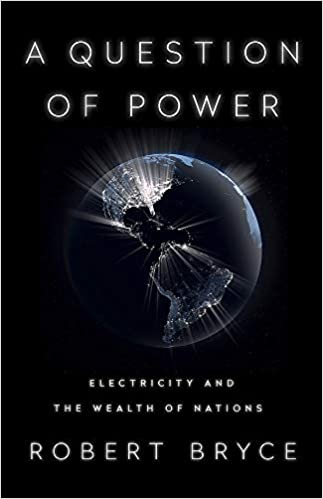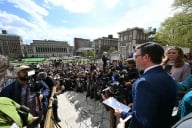You have /5 articles left.
Sign up for a free account or log in.
 A Question of Power: Electricity and the Wealth of Nations by Robert Bryce
A Question of Power: Electricity and the Wealth of Nations by Robert Bryce
Published in March of 2020.
Where does the electricity for your campus come from?
My institution produces about a quarter of its electricity in a co-generation power plant that uses Number 6 fuel oil. This electricity is a by-product of the process of creating steam to heat the buildings. (With steam heat shifting over to more efficient hot water heating). Solar panels produce about 2 percent of the electricity on campus. The rest of my institution's electricity requirements (about 50,000 MWh a year) is purchased from the grid.
Where does the electricity that my school purchases from the grid come from? The energy sources for the grid in which my school buys electricity include natural gas (48.5%), nuclear (30.5%), hydro (8.9%), wind (3.6%), refuse (3.1%), wood (2.5%), solar (1.7%). Renewables make up just over 11 percent of electricity generation.
If you find this discussion of the sources of electricity on my campus interesting, then you will enjoy reading Robert Bryce's A Question of Power: Electricity and the Wealth of Nations. If you can track down and share the sources of electricity production at your school and share them with us in the comments, you should immediately cease all other activities and download the book.
A Question of Power does three big things. First, the book is an excellent primer on all matters electrical. Bryce is very good at explaining the difference between volts, watts, and amps. The author provides a fast-paced overview of the history of electricity generation, bringing the story to the modern-day with the U.S. shift towards natural gas.
Second, A Question of Power is a passionate argument for electricity as a human right. Bryce spends time in post-hurricane Puerto Rico, Beirut, and rural India, all of which are characterized by chronic electricity shortages. It is easy to forget how closely tied are fundamental indicators of health and well-being are to electricity. Without reliable power, neither work (outside of subsistence agriculture) or education is feasible. Economic development is more of a consequence than a cause of electrification.
The third major theme in A Question of Power has to do with renewable energy. Bryce is a fan of solar power. He even has solar panels on his home in Austin. What Bryce wants to do is inject a note of realism, as the author understands reality, into the energy discussion. His essential point is that global electricity demand is too high to support a wholesale transition to renewables. This is a function of both the scale of demand (we can't put up enough solar panels or windmills) and the fact that solar and wind are intermittent. Electrical grids require reliable generation, meaning that most of the electricity will need to come from natural gas, hydro, coal, oil, or nuclear.
I'm with Bryce in his enthusiasm for nuclear power. And his indictment of the effects of windmills on people who live close by is convincing. Solar enthusiasts (such as myself) might object to Bryce's discounting of the potential of widespread adoption. He cites Germany as a case where the government's push to prioritize home solar ended up driving electricity prices. I think there is likely a more even case to be made about the potential for a combination of technological advances and government policies to dramatically increase solar electricity generation.
Fans of the Green New Deal (count me in!!) and other progressives may disagree with many of the conclusions of A Question of Power. These differences should not stop anyone from reading the book. The chapter where Bryce goes to Colorado to spend time with a marijuana grower and then dives deeply into the electricity economics of pot-growing is reason enough to read the book.
What are your favorite books about energy and electricity?
Some books on electricity and energy that I have reviewed in this space include:
- Superpower: One Man's Quest to Transform American Energy by Russell Gold
- Power Trip: The Story of Energy by Michael E. Webber
- Saudi America: The Truth About Fracking and How It's Changing the World by Bethany McLean
- Simply Electrifying: The Technology that Transformed the World, from Benjamin Franklin to Elon Musk by Craig R. Roach
- Energy and Civilization: A History by Vaclav Smil
- Energy: A Human History by Richard Rhodes
- The Grid: The Fraying Wires Between Americans and Our Energy Future by Gretchen Bakke
- Windfall: How the New Energy Abundance Upends Global Politics and Strengthens America's Power by Meghan L. O'Sullivan
- The Boom: How Fracking Ignited the American Energy Revolution and Changed the World by Russell Gold
- The Moral Case for Fossil Fuels by Alex Epstein
- On the Grid: A Plot of Land, An Average Neighborhood, and the Systems that Make Our World Work by Scott Huler
What are you reading?








